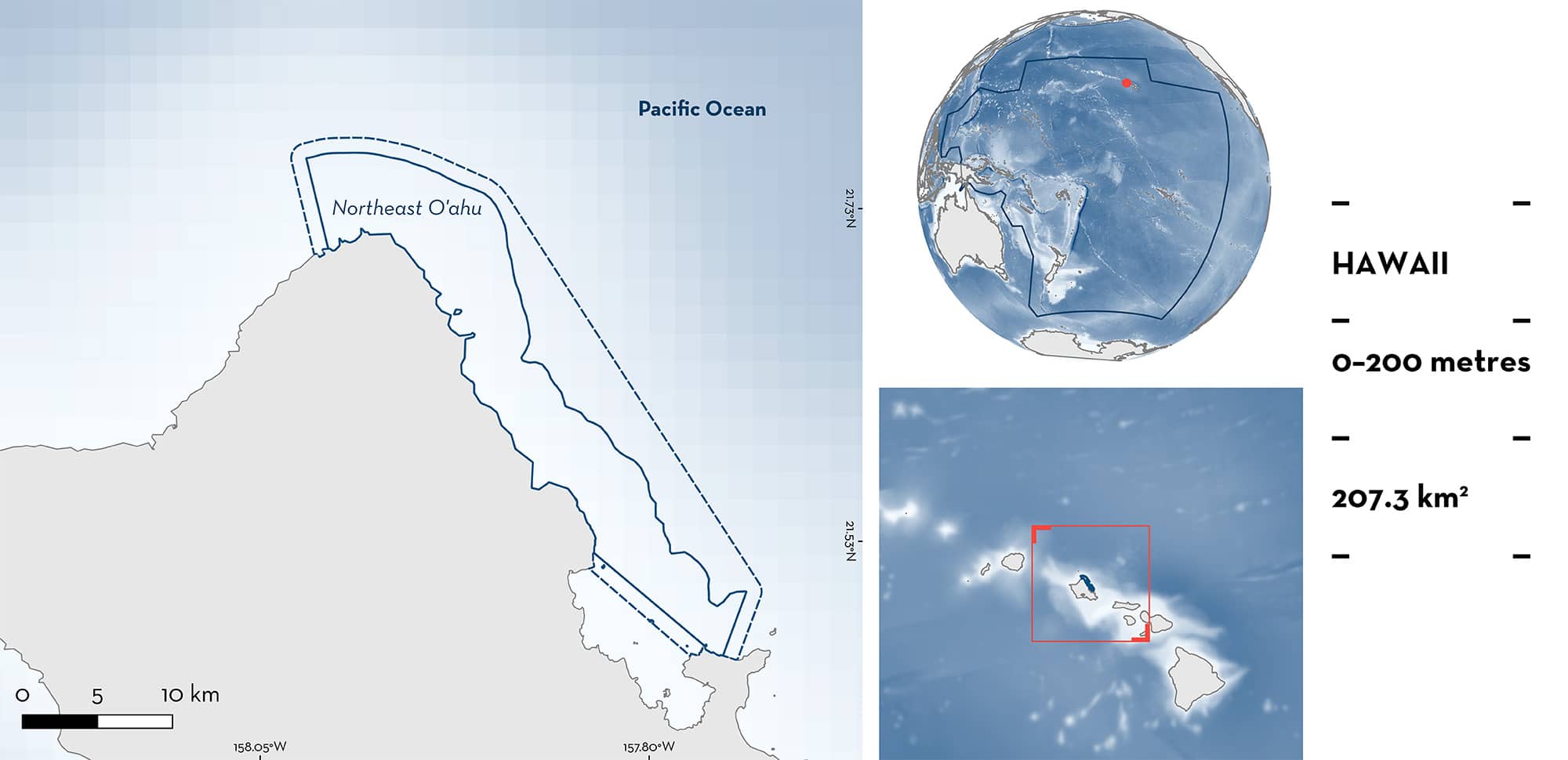ISRA FACTSHEETS
ISRA FACTSHEETS
NEW ZEALAND & PACIFIC ISLANDS REGION
Northeast O’ahu
Summary
Northeast O’ahu is located off O’ahu Island in the Hawaiian Islands of the United States of America. The area is characterised by a narrow shelf with multiple bays. Coral and rocky reefs along with sandy and rubble substrates are most common in the area. Within this area there are: threatened species (Sandbar Shark Carcharhinus plumbeus) and reproductive areas (e.g., Tiger Shark Galeocerdo cuvier).
Download factsheet
Northeast O’ahu
DESCRIPTION OF HABITAT
Northeast O’ahu is located off O’ahu Island in the Hawaiian Islands of the United States of America. It extends from Kawela in the north to Kāne‘ohe Bay in the south. The area is characterised by a narrow shelf with multiple bays. Coral and rocky reefs, sandy and rubble substrates are the most common habitat features in the area. Easterly trade winds are the main driver of the surface currents in the area and are influenced by the North Hawaiian Ridge Current (Costa et al. 2016). During boreal summer, the area is warmer with sea surface temperatures ~26°C, rainfall is low, and northeasterly trade winds and trade-wind generated swell dominate the area. While in winter temperatures are cooler (~23°C), rainfall is higher, and the area is mostly dominated by the North Pacific Swell (Costa et al. 2016).
This Important Shark and Ray Area is benthic and pelagic and is delineated from inshore and surface waters (0 m) to 200 m based on the bathymetry of the area.
CRITERION A
VULNERABILITY
One Qualifying Species considered threatened with extinction according to the IUCN Red List of Threatened Species regularly occurs in the area. This is the Endangered Sandbar Shark (Rigby et al. 2021).
CRITERION C
SUB-CRITERION C1 – REPRODUCTIVE AREAS
Northeast O’ahu is an important reproductive area for two shark species.
Between 2003–2005, 18 pregnant Sandbar Sharks were sampled offshore Kāne‘ohe Bay (Daly-Engel et al. 2007). In addition, between March 2009–April 2011, longline surveys (300–500 m with 30–50 hooks, soaking time up to 8 hours) were conducted offshore Kāne‘ohe Bay. Sixty Sandbar Sharks measuring between 45–230 cm total length (TL; converted from fork length) with a mean size of 111 cm TL were recorded at depths 60–80 m (Hutchinson et al. 2012). The reported size-at-birth for this species is 40–75 cm TL (Ebert et al. 2021), confirming the majority of individuals were young-of-the-year (YOY) or small juveniles (Hutchinson et al. 2012).
Based on fishing surveys and tagged individuals since the 1960s, Northeast O’ahu is important for mating, gestation, and pupping of Tiger Sharks (Whitney & Crow 2007; Papastamatiou et al. 2013; Meyer et al. 2018). Based on data from shark control programs using longlines and incidental catches in fisheries operating in the area, 318 Tiger Sharks (167 females and 151 males) were sampled between 1959–1960, 1967–1969, 1992–1996, and 2003–2005 (Whitney & Crow 2007). Individuals ranged between 76–447 cm TL. Of these 318 individuals, seven measured <100 cm TL, which is close to the reported size-at-birth for this species (76–89 cm TL; Whitney & Crow 2007) confirming they were either neonates or YOY. Three females were reported with mating scars and were sampled in January and February (Whitney & Crow 2007). In addition, 23 Tiger Sharks were pregnant females and were observed in all months except March and April (Whitney & Crow 2007). Early-term embryos were observed from June–February, while late-term embryos were found from September–November with females showing recent parturition sampled in October and November (Whitney & Crow 2007). Anecdotal observations from fishing surveys along the east coast of O’ahu indicates that all neonate Tiger Sharks (86–99 cm TL) were caught in October confirming that birth occurs in autumn (Papastamatiou et al. 2013). Between 2013–2015, 15 Tiger Sharks (10 females and 5 males) were tagged with satellite transmitters. Of these, six were pregnant females (Meyer et al. 2018). Individuals tagged showed high residency to O’ahu and a large number of individuals were detected in October and November in the area which matches their pupping season (Meyer et al. 2018). Additionally, some of the individuals moved to Maui which has also been proposed as a mating area (Meyer et al. 2018). During this study, females with mating scars were observed in January 2015 along with a male with fresh abrasions on one clasper indicating recent mating (Meyer et al. 2018). Of 50 female (201–450 cm TL) Tiger Sharks tagged with acoustic and satellite transmitters in Northwestern Hawaiian Islands, it was estimated that ~25% of mature females make inter-island movements to the Main Hawaiian Islands, including O’ahu, to potentially give birth there from September–November (Papastamatiou et al. 2013). Tiger Sharks in Hawaii are thought to have a triennial reproductive cycle (Whitney & Crow 2007) which explains the presence of pregnant females in the area year-round, while other pregnant females swim from the Northwestern Hawaiian Islands to Northeast O’ahu during autumn.
Download factsheet
SUBMIT A REQUEST
ISRA SPATIAL LAYER REQUEST
To make a request to download the ISRA Layer in either a GIS compatible Shapefile (.shp) or Google Earth compatible Keyhole Markup Language Zipped file (.kmz) please complete the following form. We will review your request and send the download details to you. We will endeavor to send you the requested files as soon as we can. However, please note that this is not an automated process, and before requests are responded to, they undergo internal review and authorization. As such, requests normally take 5–10 working days to process.
Should you have questions about the data or process, please do not hesitate to contact us.


